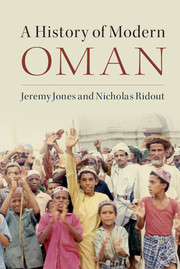Book contents
- Frontmatter
- Contents
- List of Figures
- List of Maps
- Acknowledgements
- Map
- Introduction
- Part One Foundations
- Part Two Modern History
- 4 The Sultanate as Nation, 1932–1959
- 5 Dhofar
- 6 Oil, Government and Security, 1955–1980
- 7 Shura, Diplomacy and Economic Liberalisation, 1980–2000
- 8 Oman in the Twenty-First Century
- Bibliography
- Index
5 - Dhofar
from Part Two - Modern History
Published online by Cambridge University Press: 05 September 2015
- Frontmatter
- Contents
- List of Figures
- List of Maps
- Acknowledgements
- Map
- Introduction
- Part One Foundations
- Part Two Modern History
- 4 The Sultanate as Nation, 1932–1959
- 5 Dhofar
- 6 Oil, Government and Security, 1955–1980
- 7 Shura, Diplomacy and Economic Liberalisation, 1980–2000
- 8 Oman in the Twenty-First Century
- Bibliography
- Index
Summary
The subsequent phase of political opposition to the rule of Sultan Said played out primarily in the southern region of Dhofar. It was not, however, merely a local problem. Like the struggle in the interior, it had international dimensions and, especially after 1967, as we shall see, quite serious implications for both sides in the Cold War. Within Oman, too, the armed uprising against the Sultan in Dhofar extended, primarily through clandestine networks, to Muscat and other key locations in the north of the country. But since this phase of political conflict originated in Dhofar and was shaped by the particular social and economic characteristics of the region, we begin this chapter by describing the region and its people and the circumstances from which armed rebellion emerged in the 1960s.
Ruling Dhofar
Dhofar is the southernmost region of Oman, with Yemen at its western border, and is effectively cut off from the rest of Oman by a desert region, the Jiddat al-Harisis karst, inhabited mainly by Bedouin.2 Most travel between Dhofar and the rest of Oman, until the opening of passenger air travel between Muscat and Salalah (the regional capital), was by sea. The main urban settlements in Dhofar are on the coastal plain. In addition to Salalah, Taqa and Mirbat are significant towns east of the capital, while Rakhyut, Dalkut and Mugsayl lie to the west, along the coast towards Yemen. The coastal plain is surrounded by three ranges of mountains, beyond which the Nejd eventually gives way to the sand desert of the Rub al-Khali (the Empty Quarter). Dhofar is the only part of the Arabian Peninsula to experience the Indian Ocean monsoon, which produces the khareef season between June and September, during which mist hangs over the mountains, rain falls and a startling profusion of green vegetation transforms the landscape.
The physical distinctiveness of the region is compounded by strong cultural differences between Dhofar and the rest of Oman, of which perhaps the most striking is language: a number of non-Arabic languages are spoken by the inhabitants of Dhofar.
- Type
- Chapter
- Information
- A History of Modern Oman , pp. 132 - 160Publisher: Cambridge University PressPrint publication year: 2015



